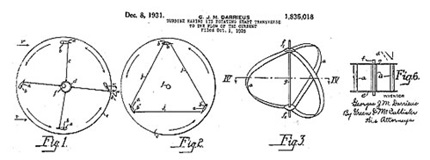Design philosophy
The new proposed floating offshore wind turbine concept has been called DeepWind because of the feasibility to exploit wind resources at deep water sites. DeepWind consists of few components for easy manufacture.
A long vertical shaft, approximately twice the height of the rotor, rotates slightly tilted in water. Above sea level a vertical-axis mounted rotor converts the wind forces into mechanical energy, and below sea level a direct drive (DD) generator transforms the mechanical energy into electricity. A torque balancing mooring system at the generator casing connects the wind turbine to the sea-bed fixing system. To achieve equilibrium of wind forces, the rotating and floating hollow shaft must be balanced by buoyancy and counter weight accordingly also to take into account wave and current loads. With the potential of the new blade manufacturing technology, very long blades can be pultruded. Therefore large rotors with large MW capacity are within reach and hence the need for deep water sites. A floating platform is a promising candidate for such specific offshore deep sea technology. However, a number of specialized research topics have to be considered in order to develop and built such wind turbines.
Power conversion is performed with a vertical-axis wind turbine via a very long and hence flexible shaft extending deep into the sea. Despite the simple DD design, dynamics and movements of the rotating shaft represents an engineering design challenge.
The Darrieus rotor was invented to achieve power from the excess of aerodynamic lift rather than the aerodynamic drag. In comparison with windmills the performance was improved considerably. The picture below show the possible configurations of the concept, which also covers a straight bladed version (H-Darrieus).
 Objectives
Objectives
The hypothesis of this project is that this new floating wind turbine concept developed specifically for offshore application has potential for better cost efficiency, and for re-addressing the distribution of costs for offshore wind turbines. Based on this hypothesis, DeepWind deals with the overall objective:
To explore the technologies needed for development of this new simple offshore deep water MultiMegaWatt wind turbine with a vertical-axis rotor and a floating and rotating foundation.
The consortium aims:
- To develop calculation- and design tools for development and
- To evaluate very large floating Darrieus based on this concept, and further
- To demonstrate the technical feasibility of the concept in a proof-of-principle.
The technology behind the proposed concept presents extensive challenges and requires technological breakthroughs needing explicit research in a wide area of different technology fields and materials, especially: dynamics of the system, pultruded blades with adequate material properties, sub-sea power generator and power converter, turbine control and safety system, wave and current loads on the rotating and floating shaft, and the mooring and torque absorption system.
For evaluation of the overall concept and in order to be able in detail to evaluate the concept against floating offshore horizontal axis wind turbines, exploration of the technologies is needed for the individual components and subsystems.
To reach this goal the following scientific and technological objectivesB 1.3 are defined (WP numbers refer to work packages to be described in ) with deliverables as in WT2 and milestones as in WT 4:
- To develop numerical tools for prediction of energy production, dynamics, loads and fatigue. (WP1)
- To develop tools for design and production of pultruded blades (WP2)
- To develop tools for design of submersible and high torque generator concepts (WP3)
- To develop a rational control and safety concept for the turbine (WP4)
- To develop a feasible floating support structure for torque absorption (WP5)
- To explore hydrodynamic loads on a rotating shaft in uniform water flow (WP6)
The technologies need verification, and DeepWind verification is made by:
- The feasibility of the concept is validated in a Proof-of- Principle experiment and component experiments contributing to the understanding of the special conditions of parts of the concept in basin tests are explored and validated (WP7)
The evaluation of the perspectives for the concept is made by
- Integration of all technologies in demonstration of the possibility of building a 5MW wind turbine based on the concept and an outlook towards upscaling to 20 MW (WP8)
Finally, DeepWind results are prepared for public and industry in the work package
- Dissemination and exploitation of results (WP9).
In summary, the following scientific and technological objectives address the topics mentioned in this project:
- DeepWind operates within the premises of cross-cutting technologies mentioned in 1-9 that needs coordinated development and application of basic science
- DeepWind is a new concept at high risk and dependent on programmes, which ensure that the ideas based on emerging technologies representing technological bottlenecks are funded. On implementation DeepWind rewards high risk with high potential impact for the energy sector.
- DeepWind embraces research which brings technologies mentioned in 1-9 from different fields/disciplines together and is managed by a competent consortium. Capacity is built from knowledge of technologies and materials in a novel mix and working across traditional technological boundaries and across borders.
- DeepWind comprises research directed towards demonstration and feasibility of the emerging technology
- DeepWind brings about a concept combining technologies into a new field of technology ahead of conventional approaches.
Because DeepWind is a MultiMegaWatt wind energy system for non-pollution and sustainable electricity supply it is fully coherent with the objectives in FP7.